Some of the links in this post may be affiliate links.
Lipstick plants, or Aeschynanthus radicans, are one of my favorite flowering indoor plants. The vigorous, glossy leaved vines and exotic flowers, reminiscent of lipstick coming out of a tube, make for an amazing hanging basket or even a trailing plant on a shelf.
Whether you want to save a dying plant, or maybe you already have a healthy plant and you want it to bloom, this post has everything you need to know about lipstick plant care.
Everything from light, watering, humidity, soil, fertilizing, flowering, and propagation is discussed. In addition, I’ll go into the different varieties of lipstick plants, as well as answers to commonly asked questions so that you can make sure to have a full, thriving specimen that is exploding in blooms!
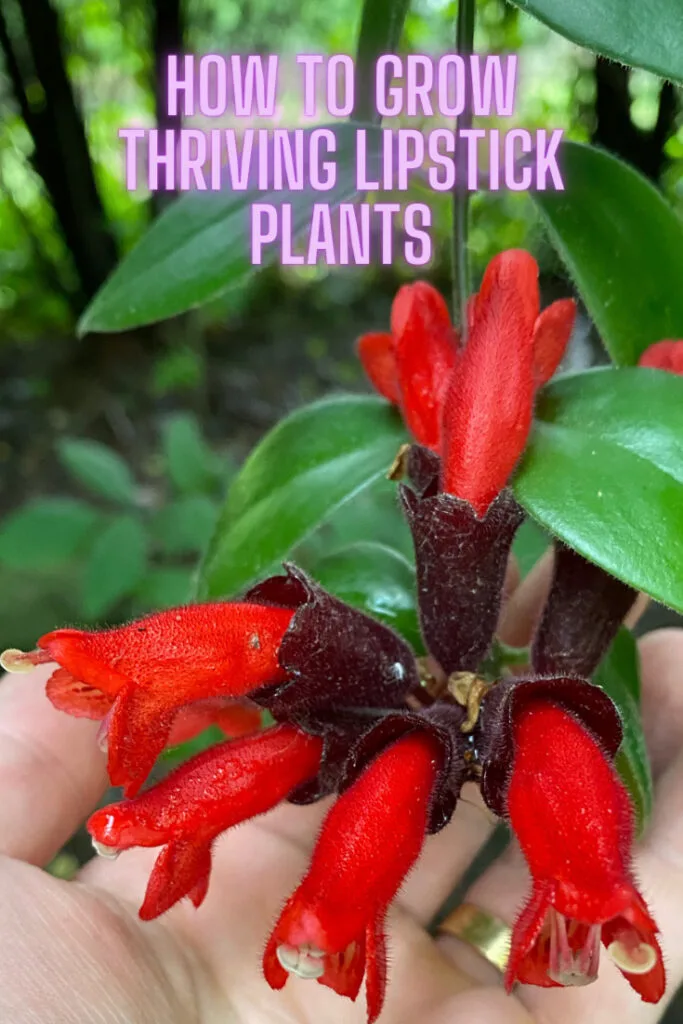
Aeschynanthus radicans is a member of the Gesneriad plant family (like African Violets) and are native to the warm, steamy tropics of Borneo, Malaya, Sulawesi, Sumatera and Thailand according to Kew Gardens. This should give you good clues as to the conditions that it thrives in.
Now let’s get into lipstick plant care!
Table of Contents
LIPSTICK PLANT CARE
1. LIGHT
In order to have your plant flower, it is really important that you situate your plant directly in front of a window for best growth and flower production. I’ve grown these plants in a variety of locations successfully, so I’d like to describe these locations so that you can get a feel for what works with this plant.
Indoors, these plants will do well in front of a bright window, provided that it is not sitting in all-day direct sun. If you live in the Northern hemisphere, a big Northern exposure window would be a bare minimum that I’d recommend. These windows will get no direct sun at all.
If you live in the Southern hemisphere, the equivalent would be a Southern facing window.
Even better, regardless where you live, would be an Eastern facing window (morning sun) or even Western facing windows (afternoon sun).
Other great options are right under a skylight (mine is currently in this type of growing location). It receives bright, indirect light for most of the day, but does receive a couple hours of direct sun on some days.
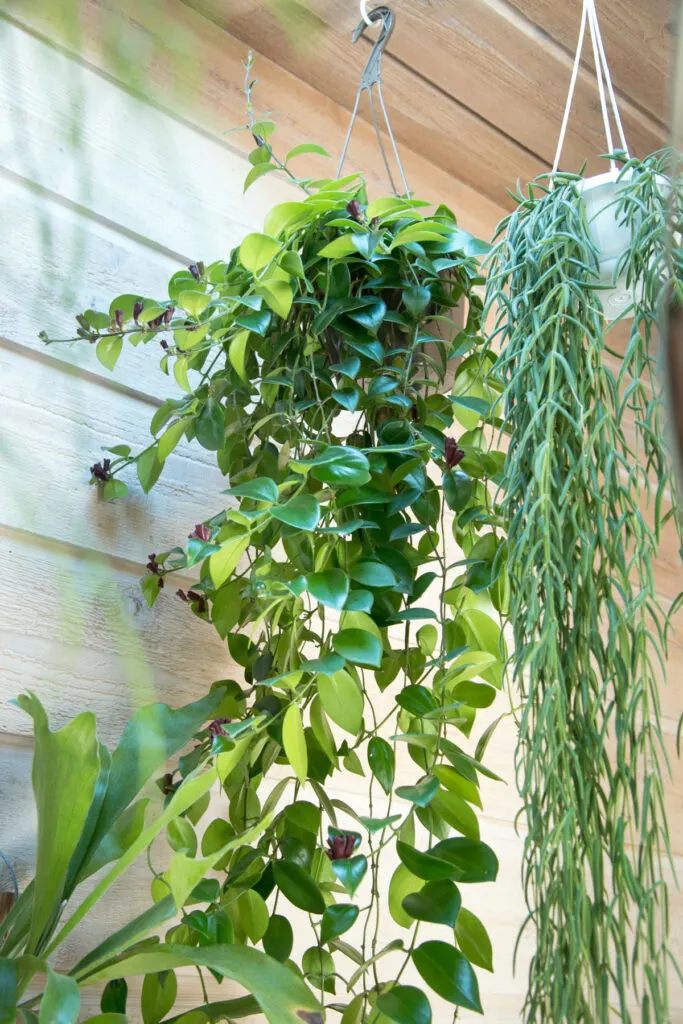
If you have a particularly sunny window, you can diffuse the light with sheer curtains or blinds. Growing up, I grew a gorgeous lipstick plant specimen in a very sunny southern window, but I diffused the light a bit so that it wasn’t sitting in sun all day.
You’ll know if your plant is receiving too much light because the leaves will turn a reddish purple. This is not cause for alarm necessarily, as long as the foliage isn’t bleaching out, but you may want to decrease the light a bit.
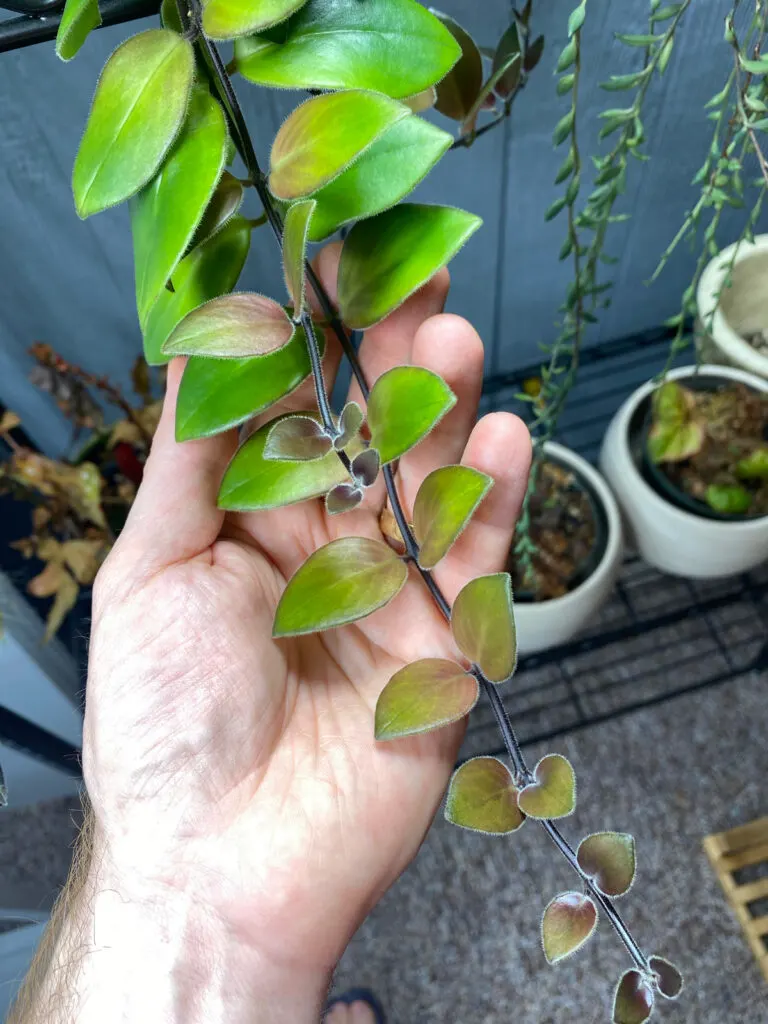
2. WATERING
Lipstick plants prefer an evenly moist potting mix. They absolutely detest drying out completely, so try and avoid this at all cost.
My rule of thumb is to allow approximately the top inch of the potting mix to dry out, and then water thoroughly. Let excess water drain through the drainage holes and discard any excess water that may accumulate in the saucer or cache pot.
Like most houseplants, do not allow your plant to sit in leftover water for extended periods as this can lead to root rot.
Know that thorough watering does NOT equate to “overwatering.” In most cases, if you have your plant in sufficient light and have an appropriately sized pot, you should have no concern of “overwatering.”
Ironically, many people are so scared to water plants properly that they often end up dehydrating their plants because of the fear of overwatering. If all your other conditions are good, you should be good to go.
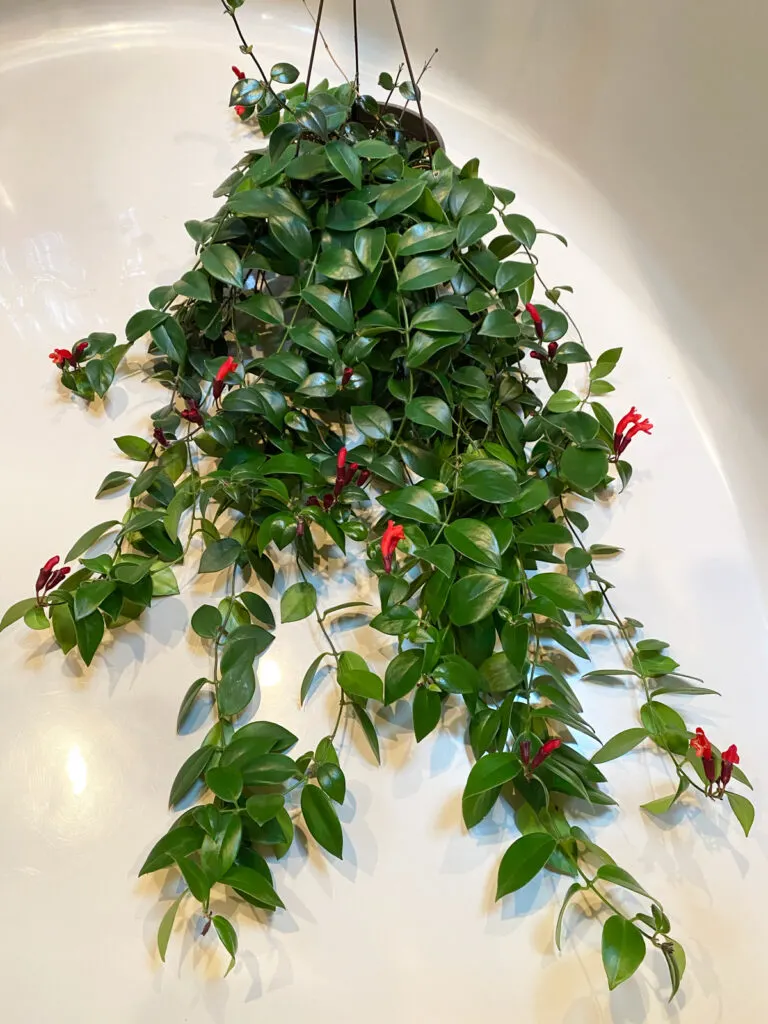
3. TEMPERATURE & HUMIDITY
These jungle plants enjoy warm and humid conditions. If I were to prioritize the two factors of temperature vs. humidity, ensuring that you can supply necessary warmth is much more important than any efforts to
In my experience, they grow more quickly and experience no leaf drop if you can keep conditions warm and toasty. I have one plant that I propagated in my basement under grow lights, and it stays a consistent 75F and it loves these conditions.
An ideal temperature range to shoot for would be 65-85F (18-30C).
Conversely, my sunroom will tend to stay cooler and during the wintertime, and the plant I have there often experiences some leaf drop as a result of cooler temperatures (in the 60s F during the day and slightly cooler at night).
During the winter, I do like to run a humidifier though in my sunroom. One of my favorite humidifiers that I highly recommend is the Levoit 6L humidifier.
Another humidifier that I recommend are the ones from Miro. They are beautiful and easier to clean and fill than the Levoit, though I highly recommend both! If you are interested in a Miro humidifier, be sure to use code OHIOTROPICS to receive 10% off!
For a more details discussion on humidity, be sure to read my blog post on raising humidity for houseplants: 1 Awful + 3 Great Ways to Increase Humidity for Houseplants.
4. SOIL & REPOTTING
A light, fluffy well-drained mix is perfect for these plants. Depending on what I happen to have on hand, I’ll use 2-3 parts of either an all-purpose potting mix or even African Violet mix, to which I add 1 part perlite.
As far as pot type goes, you have many options. You may want to avoid terra cotta pots since they tend to dry out super quickly.
If you need a reference to help you choose, be sure to check out my indoor plant pot types post.
As far as repotting goes, I’ve kept my plant in the same pot for quite a few years, but it will eventually get to the point where it will be difficult to keep the plant watered enough.
When you do repot, be sure to only go up one pot size (for example, from a 6 inch pot to an 8 inch pot). If you go much bigger, it will take too long for your potting mix to dry out and this can cause some issues.
In addition, be sure to loosen the root ball when before you place your plant in it’s new pot. For a visual tutorial on repotting, check out my blog post on how to properly repot a houseplant. In that post, I show an example of a great hanging planter that I absolutely love for trailing plants!
5. FERTILIZING
My absolute favorite fertilizer that I love using for this plant, and it has resulted in luxurious growth and flowering, is Dyna-Gro Grow.
It contains all the necessary macro and micro nutrients needed for plant growth. I fertilize dilutely with every watering with 1/4-1/2 teaspoon per gallon of water.
6. FLOWERING
As I previously mentioned, sufficient light is needed in order to encourage blooming. If your plant is not blooming, go back and reread the Light section of this post and move your plant to a brighter location.
Flowering is the reason why we grow these plants, so be sure your plant is getting sufficient lighting!
It’s fun to watch the progression of lipstick plant flowers. The flowers on the plain old Aeschynanthus radicans start off as dark purple or maroon “lipstick tubes” as I call them:
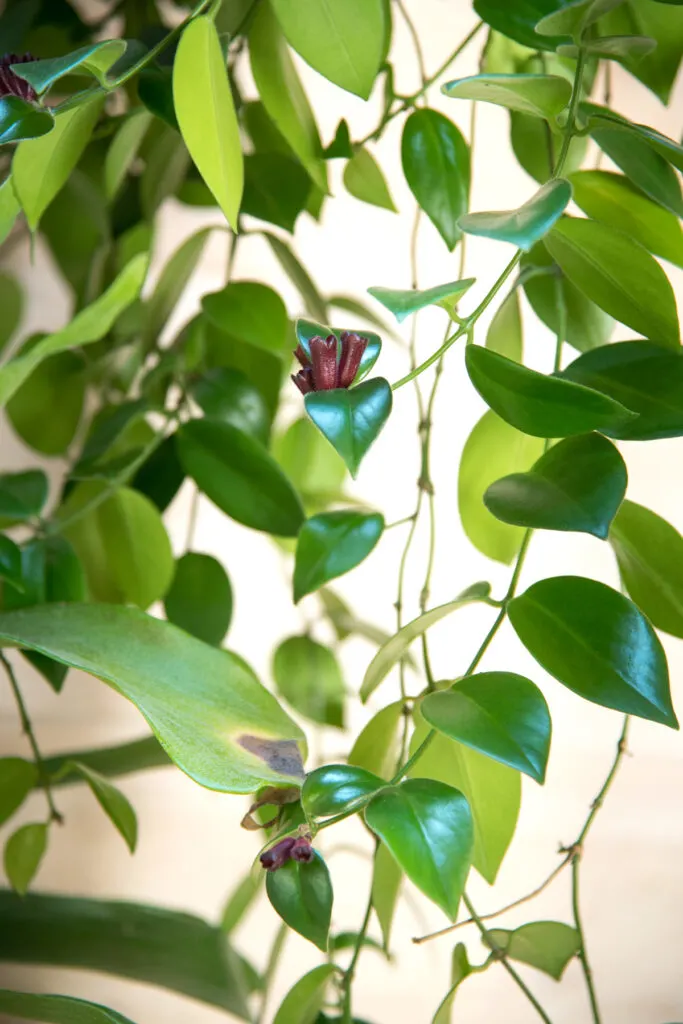
Once the flowers grow a bit, you’ll notice the red portion of the flower start to pop out of the middle:
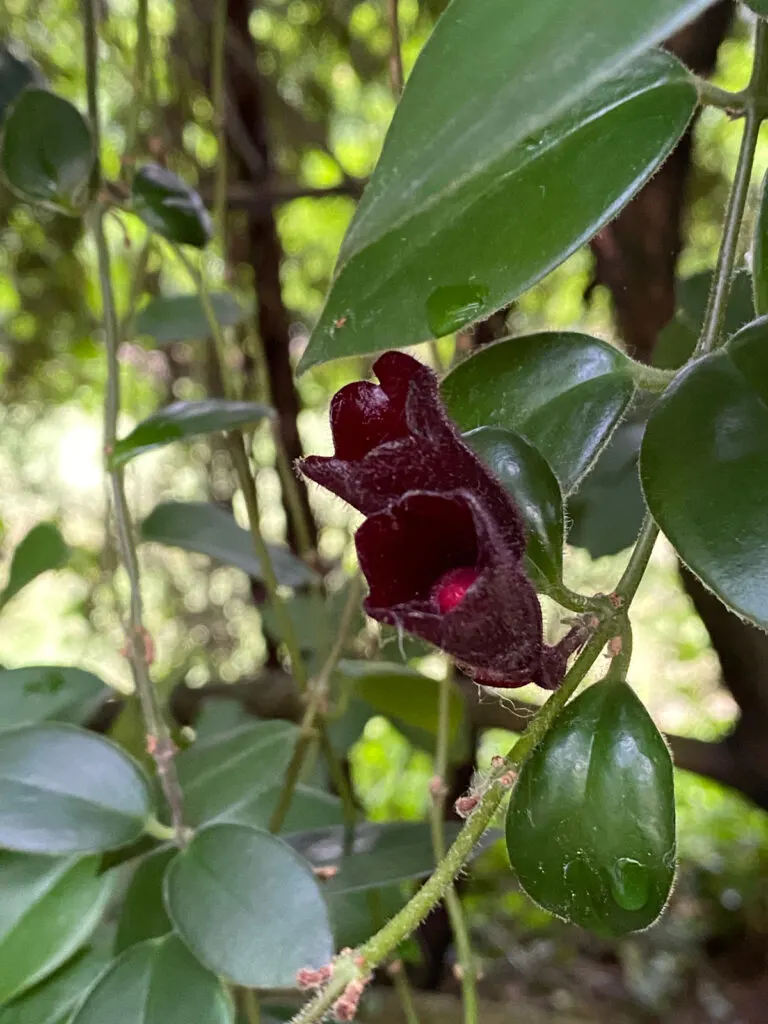
Finally, here are several flowers that have fully opened:
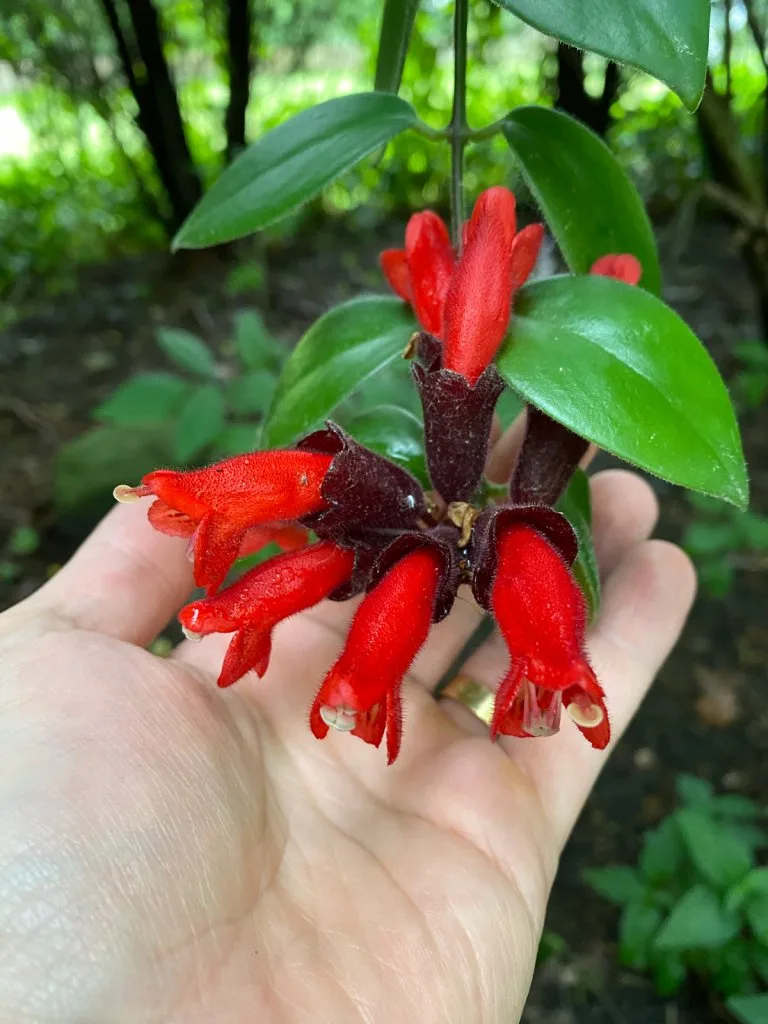
As far as the bloom period goes for this plant, mine has flowered in all seasons, but flowering tends to be most abundant for me in the summer time, especially since I move my plants outdoors in the shade. It relishes the abundant rain, humidity, and air circulation found outdoors.
If you move any of your plants outdoors, be sure to gradually acclimate your plant to higher light. I discuss this very important topic in my When to Put Plants Outside in Spring post. I have important tips on acclimating to higher light so that your houseplants don’t burn.
A well-cared for plant will reward you with plenty of flowers throughout the year! Especially if you have an older plant.
7. PROPAGATION
Stem cuttings are the easiest way to propagate this plant. They will root readily either in water or directly into potting mix.
Make cuttings that are about 4-6 inches long. Remove the bottom one or two leaves, and you can either root them in water at this point, or in soil.
For water propagation, wait until the roots are about 1/2 inch to an inch long, and then plant them in a pot.
If you prefer soil propagation, dip the ends of the cuttings into rooting hormone, and then place them into a small pot with potting mix. Keep the mix relatively moist to encourage rooting. You may also want to
I’ve done both water and soil propagation methods successfully so choose whatever you are most comfortable with.
For more detailed instructions on how to propagate, check out my lipstick plant propagation blog post where I discuss step by step with photos.
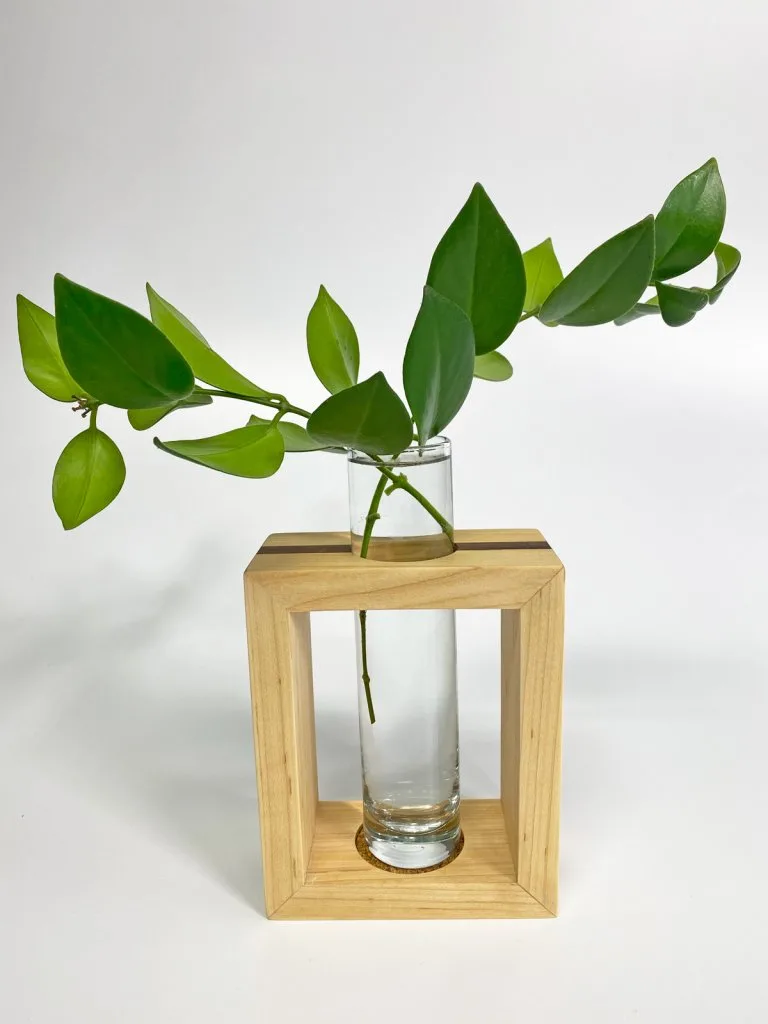
VARIETIES OF LIPSTICK PLANT
There are quite a few gorgeous varieties of this plant, with different shape and color leaves and flowers. Flowers come in red, yellow, orange, and even pink.
Besides the plain Aeschynanthus radicans that I’ve featured in this post, here are some other lovely varieties:
Variegated Lipstick Plant (Aeschynanthus radicans ‘Variegata’)
This is my own variegated plant that I grew from cuttings. It has not bloomed yet, but the leaves sure are gorgeous. It would benefit from a brighter location to bring out more of the lovely variegation.
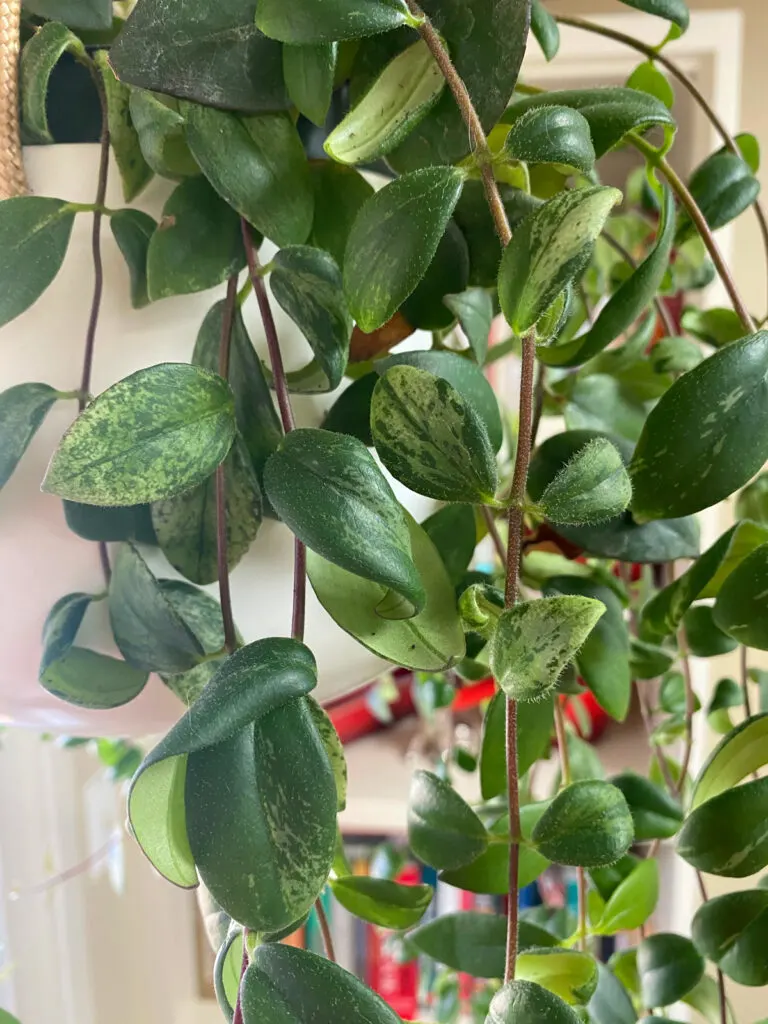
Orange Lipstick Plant (Aeschynanthus speciosus)
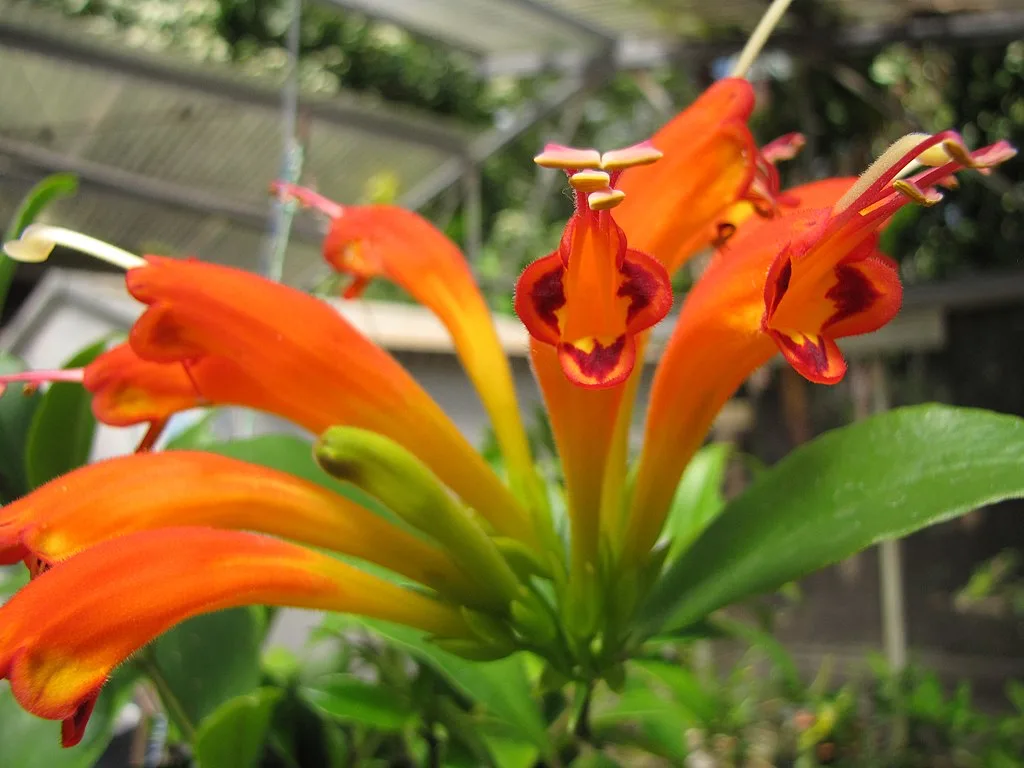
Yellow Lipstick Plant
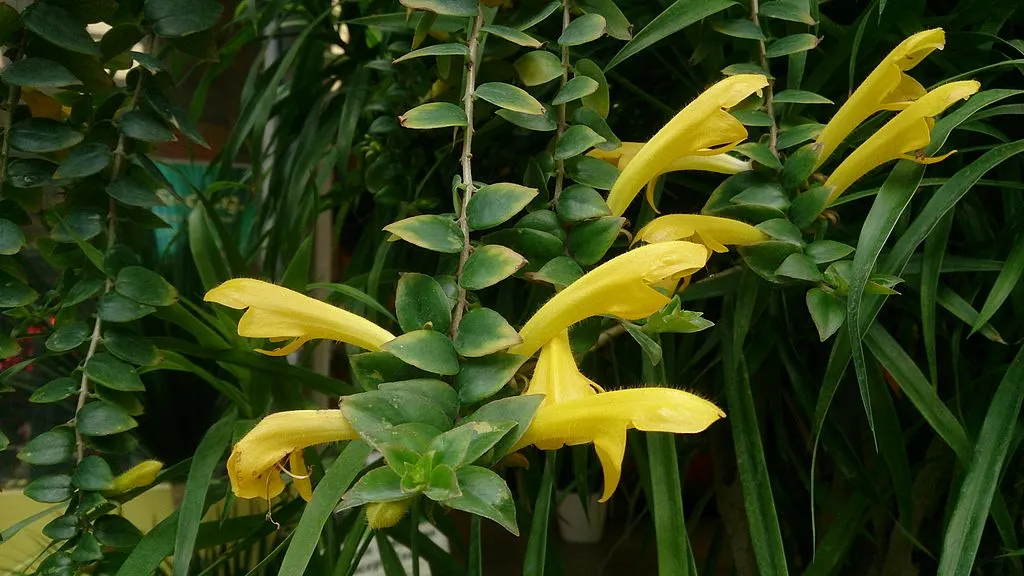
Pink Lipstick Plant
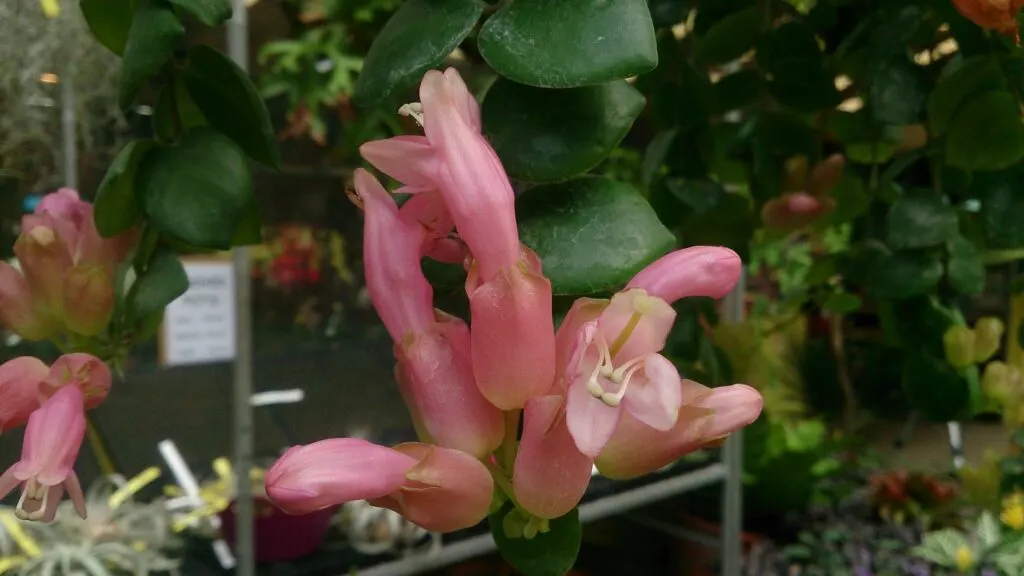
Another unusual variety with twisted and crinkly leaves is the Curly Q Lipstick Plant (Aeschynanthus radicans ‘Curly’)
LIPSTICK PLANT FAQs
Why is my lipstick plant dropping leaves?
There can be multiple reasons why this occurs. The most common reasons leaf drop occurs are cool temperatures and also improper soil moisture. Try and avoid cold, drafty locations and keep your plant in a warm spot. Soil that is too dry or too wet can also cause this to occur, so learn to maintain a good moisture level that your plant is happy with.
Why is my lipstick plant not flowering?
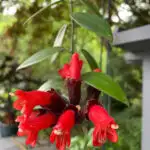
The most common cause of lack of flowering is insufficient light. If your plant is not blooming, move it to a brighter location. Also, be sure to regularly fertilize, especially if you are moving your plant to a brighter location.
Why are there yellow leaves on my lipstick plant?
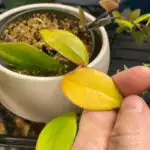
Yellow leaves, like any plant problem, can be caused by a variety of issues. Allowing your potting mix to go completely dry will rapidly cause yellow leaves, typically starting at the base of the vine, as shown in the photo. It can also be caused by root rot, too little or too much light, and can also occur if you have a severely root bound plant where it is difficult to keep up with watering.
Why are my lipstick plant leaves shriveled and curled?
Go ahead and feel your potting mix. Is it completely dry? This is the most common reason for shriveled and curled leaves.
What do I do with bare, leafless vines?
If the vines are completely dry and leafless, go ahead and prune those completely off.
How can I rejuvenate my lipstick plant that has lost a lot of leaves?
My top recommendation to fix this, other than trying to provide all the cultural conditions described in this post, is to give your plant a good pruning and move it outdoors in a shady spot when temperatures are warm enough. Don’t be afraid to prune. Your vines will often branch out and this can also force growth to occur at the base of the plant, resulting in a fuller plant. You will be amazed what a good pruning and summer outdoors can do. Your plant will explode into growth.
What should I do if my lipstick plant vines lost leaves at their tips?
Simply prune off the bare portion of the stem, and cut it back to a portion of the vine that has leaves. New vines will grow.
Are lipstick plants toxic to pets?
According to the ASPCA, they are not toxic to dogs, cats and horses.
Do you have a lipstick plant? Comment below, I’d love to hear!

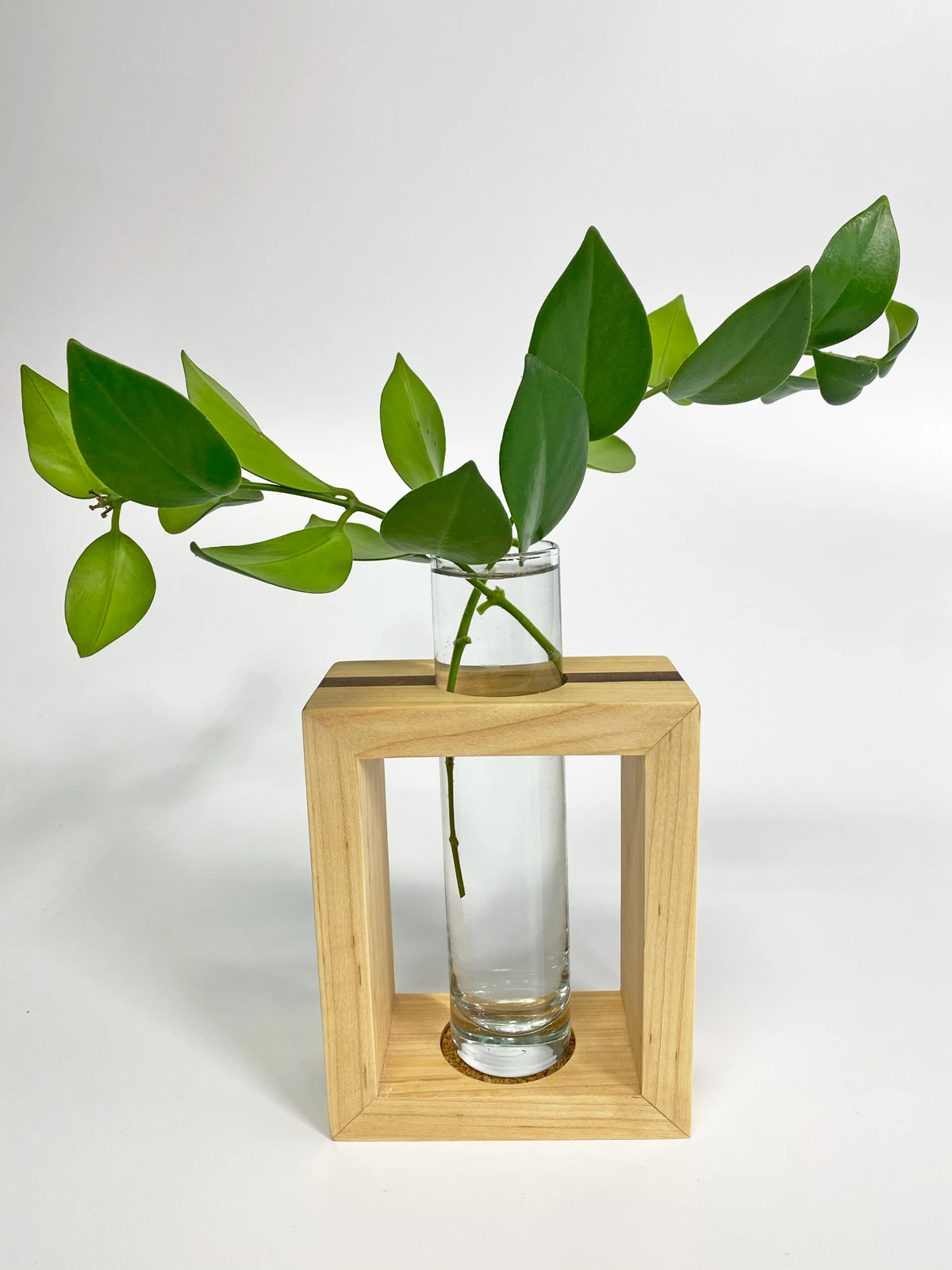
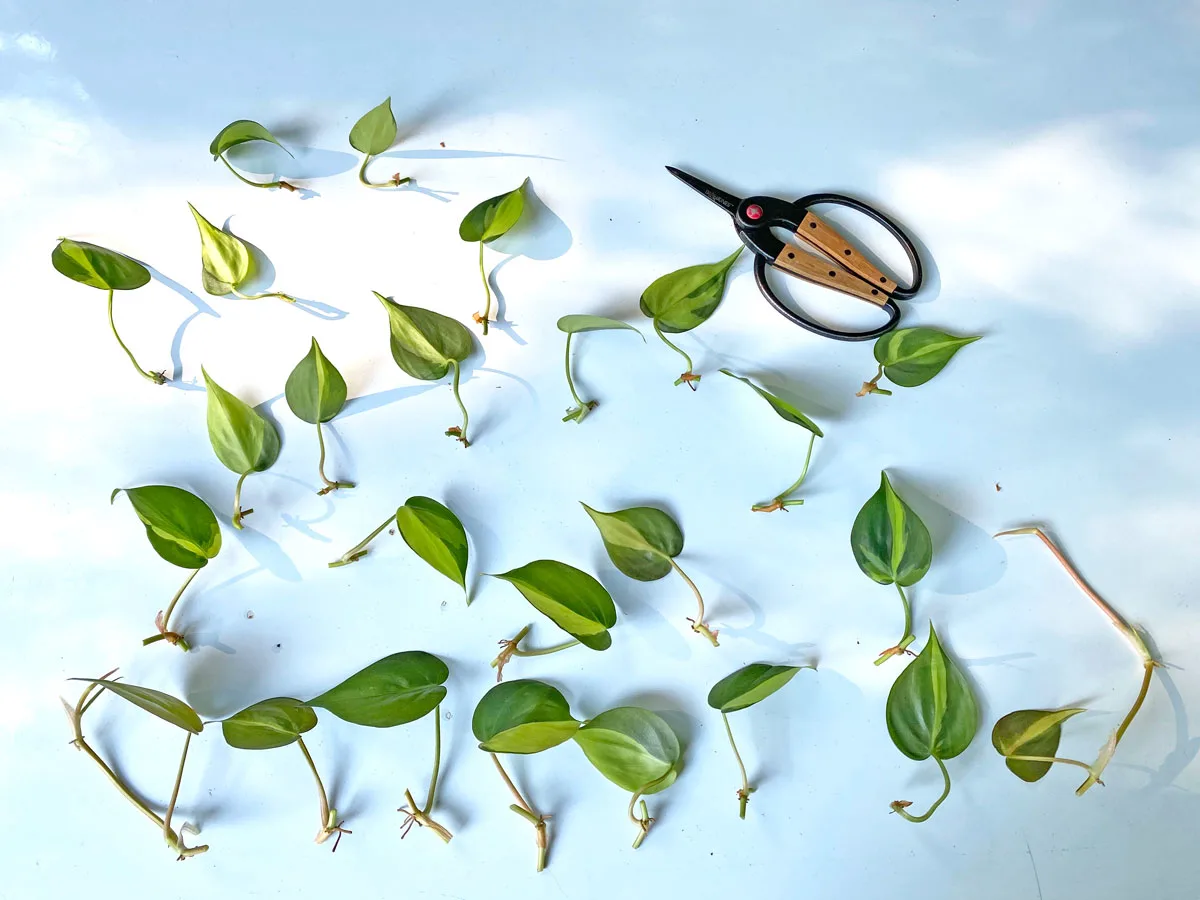

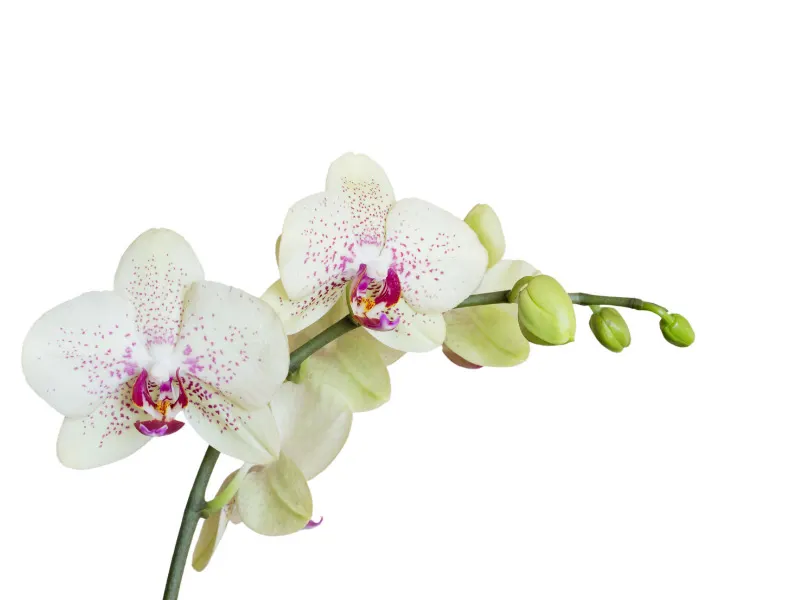
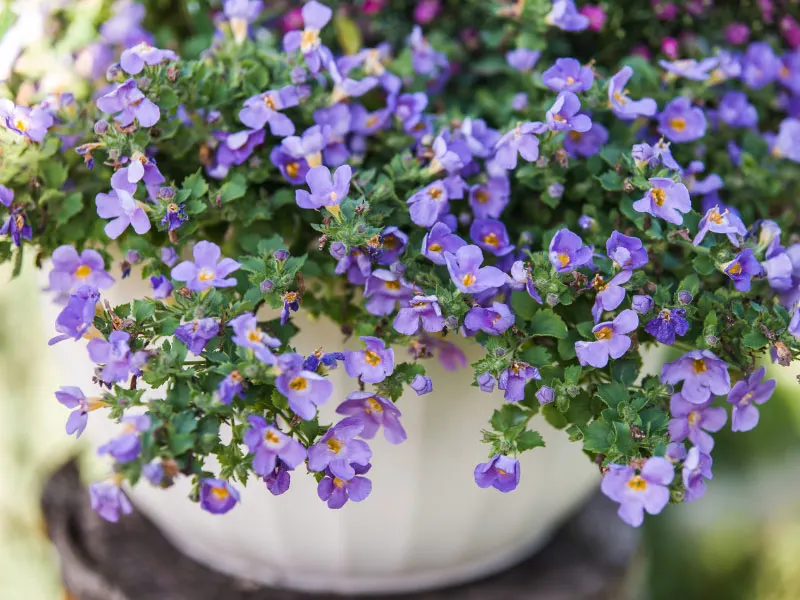
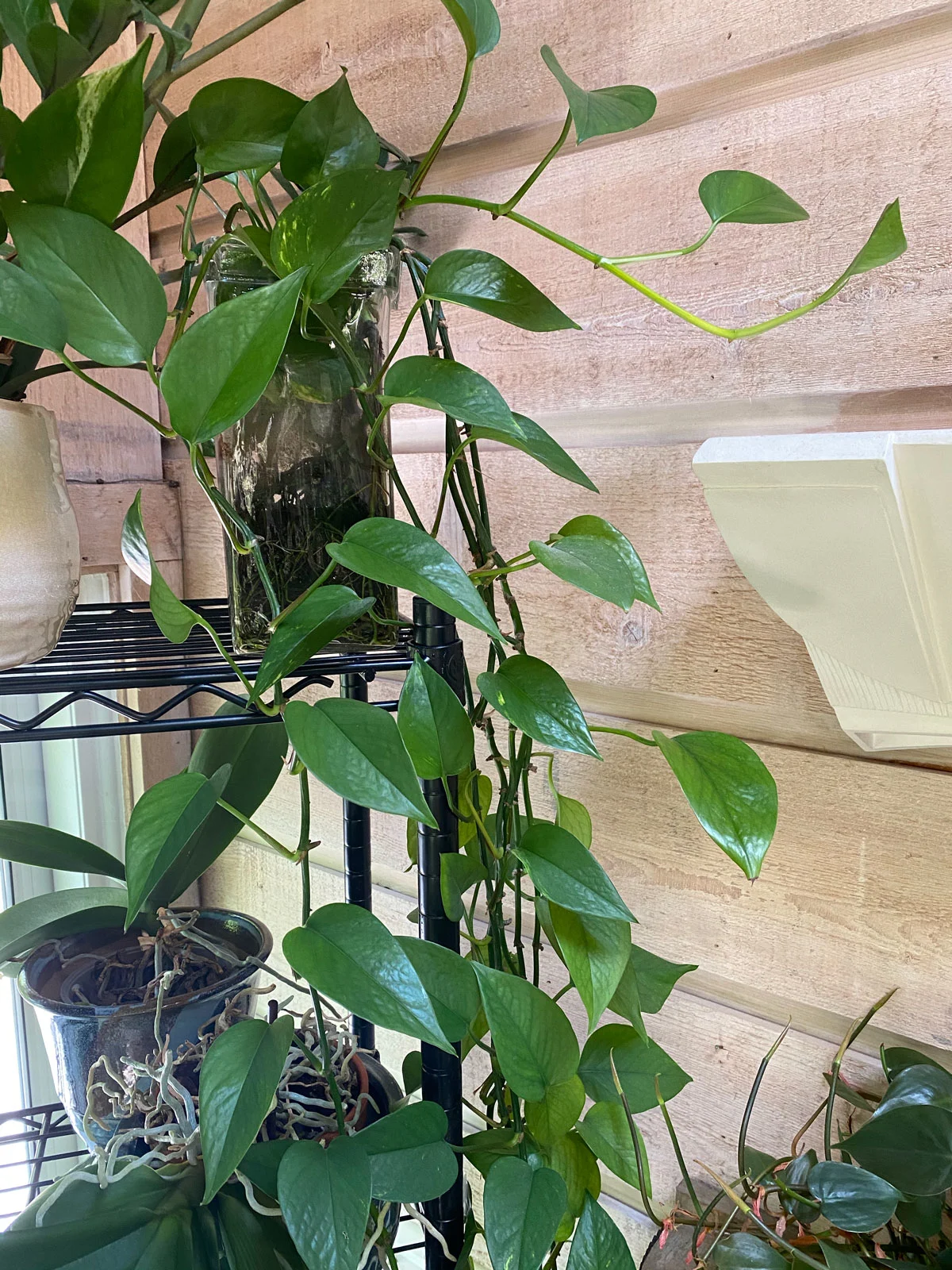
Gloria
Wednesday 14th of February 2024
I have had a lipstick plant for about 10 years and it has never bloomed. I bought a grow light for it about 4 months ago. Still no blooms. Does the grow light offer enough light?
Raffaele Di Lallo
Thursday 15th of February 2024
I would need more details. Where did you have the plant for the 10 years? How far from a window and what exposure? What kind of grow light did you get exactly?
Suzy
Thursday 27th of July 2023
Hello! I have a curly lipstick plant, and a lot of leaves fall from it, whole ends, blackened and shriveled leaves, etc. It is placed on the side of a western window so that it is not exposed to direct sunlight, but it is not a very bright place, the average temperature in my house is probably between 20-25 degrees, there is a spider plant next to it for moisture and it gets watered twice a week. It is quite new but from the first day (already in the store) it was like this, what should I do?
Raffaele
Saturday 29th of July 2023
Hi Suzy! Can you tell me how you water and how you determine when to water? It does sound like your plant needs more light for sure. Has your soil gone completely dry by any chance? This will quickly cause a lot of lower leaves to fall.
Angela
Friday 5th of May 2023
Just found your blog and wanted to say I have an adorable curly lipstick plant that I bought at a farmer's market almost 2 years ago...named Hector Pablo. I have to say...I'm normally a brown thumb at best having not received any of the prolific green thumbs from my mother or grandmother. I'm THRILLED that this little guy is thriving. I've managed to propagate him and now have a second pot that is thriving as well! I live in southern Texas so the climate here seem to agree with him. No specific question, just wanted to say thanks for posting so much wonderful, helpful information to keep my little guy happy! Bookmarked for sure!
Raffaele
Sunday 7th of May 2023
You're so welcome Angela! I'm happy that you're doing well with your plant and that you're enjoying my blog :-)
Cindy
Wednesday 1st of March 2023
I stumbled across your website and was delighted to find such good tips for growing lipstick plants. I have had one for decades and it has never bloomed. I'm guessing it does not get the right light. Oh well, I'm just happy I've kept it alive for so long. I did learn that I do not water it as often as I should, so I will start that right away. Also, I have never fertilized it. So I'll give that a try.
Raffaele
Wednesday 1st of March 2023
Glad you enjoyed the post Cindy! And good luck with your plant. Increasing the light and fertilizing should trigger your plant into blooming. Good luck :-)
Cal
Thursday 10th of November 2022
Thanks for such an informative post, Raffaele! I’ve had a beautiful lipstick plant since March, and it was quite happy with me for months (lots of blooming!) but things have gone downhill since late summer. We had a house sitter who forgot to water the poor thing for almost two weeks, and then I’ve been watering it regularly and thoroughly since, but it’s only bloomed twice more. It’s also been producing lots of yellow leaves, first only near the roots but now further down as well. I’ve been removing the yellowed leaves but they just keep coming… I can’t tell if my plant is depressed from the summer dry spell, or the newly cold temperatures/drafty window, or the low autumn light. My apartment gets little light to start with but I’m doing my best with her hanging in the brightest window. Oh and the yellow leaves are primarily on the side facing away from the window. What do you think I need to do to make this poor plant happy? Rotate it? Artificial light? Crank the heat? Perhaps fertilizer- although from reading your post, looks like I missed the spring/summer window, so maybe it’s too late? Let me know what you think.
Raffaele
Friday 11th of November 2022
Hi Cal, can you tell me what the temperatures are? I would rotate the plant regardless for even growth. It's hard to go too much in depth without asking a ton of questions. :-). Sometimes even after you correct the watering (from being really dry...) some leaves will continue to yellow. It's a delayed effect. Maybe try a grow light, be consistent with watering, and try and keep your plant away from any cold drafts and cool temps. If you have your plant under a grow light, you can still repot if it needs it.